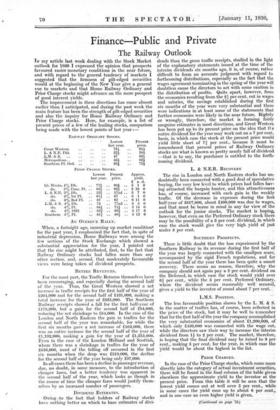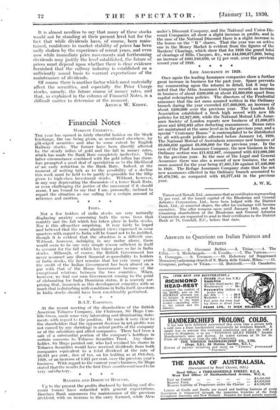Finance—Public and Private
The Railway Outlook
IN my article last week dealing with the Stock Market outlook for 1930 I expressed the opinion that prospects favoured easier monetary conditions in the near futuie, and with regard to the general tendency of markets I suggested that the firmness of gilt-edged securities would at the beginning of the New Year give a general cue to markets and that Home Railway Ordinary and Prior Charge stocks might advance on the mere prospect of good interest yields. The improvement in these directions has come almost earlier, than I anticipated, and during the past week the main feature has been .the strength of gilt-edged securities and also the 'inquiry for Home Railway Ordinary and Prior Charge stocks. Here, for example, is a list of present prices of a few of the leading stocks, comparison being made with the lowest points of last year
RAILWAY ORDINARY STOCKS.
Great Western L. & N.E. Pfd.
& S. • .. Metropolitan.. Southern Pf. Ord.
PRIOR CHARGE STOCKS.
_ .
Gt. Westn. 4% Db. do. 5% Cons. Pf. L. & N.E. 3% Db. ' do. • 4% lst N. do. . 4% 2nd Pf. L.M. & S. 4% Db. du. 4% Pf. do. 4% 1923 Southern • 5% Pf. Lowest last year.
.. 77i
• •
881 • .. 531
• •
.. 611
• •
.. 49
• •
.. 74
• •
641.
• •
.. 63i
• •
.. 81f
• •
Present price.
80} .. 921 .. 57xd ..
67 ..
62 ..
77xd ..
711 .. ..
89f .. Approx. yield.
£ s. d.
5 1 0 5 10 0 5 7 0 6 1 0 6 11 0 5 5 0 5 14 0 5 17 6 5 13 0 AN OVERDUE RALLY.
When, a fortnight ago, summing up market conditions for the past year, I emphasized the fact that, in spite of industrial depression, Home Railways were among the few sections of the Stock Exchange which showed a substantial appreciation for the year, I pointed out that the rise might be attributed, first, to the fact that Railway Ordinary stocks had fallen more than any other section, and, second, that moderately favourable views were being taken of dividend prospects.
BETTER REVENUES.
For the most part, the Traffic Returns themselves have been encouraging, and especially during the second half of the year. Thus, the Great Western showed a net increase in traffic receipts for the first half of the year of £204,000 and for the second half of £431,000, making a total increase for the year of £685,000. The Southern Railway receipts showed a fall for the first half-year of £178,000, but a gain for the second half of £94,000, reducing the net shrinkage to £84,000. In the case of the London and North Eastern the gain in traffics for the second half of the year was remarkable, for while the first six months gave a net increase of £163,000, there was an entire increase for the second half of the year of £1,192,000, making a gain for the year of £1,855,000. Even in the case of the London Midland and Scottish, where there was a shrinkage in traffics for the year of £616,000, most of the falling off occurred in the first six months when the drop was £519,000, the decline for the second half of the year being only £97,000.
In all cases there has been a decline in passenger revenue, due, no doubt, in some measure, to the introduction of cheaper fares, but a better tendency was apparent in the second half of the year, which looks as though in the course of time the cheaper fares would justify them- selves by an increased number of passengers. , .
DIVIDEND ESTIMATES.
Owing .-.to the fact that holders of Railway stocks have nothing better on which to base estimates-of divi- Lowest last year. 78 22 47 55f 69} Present price. .. 91} . 38} . 56f 621 73} dends than the gross traffic receipts, studied in the light of the explanatory statements issued at the time of the interim dividends six months ago, it is, of course, rather difficult to form an accurate judgment with regard to forthcoming distributions, especially as the fact that the wages agreement terminating in the spring of the year will doubtless cause the directors to act with some caution in the distribution of profits. Quite apart, however, from the economies resulting from the 2i per cent. cut in wages and salaries, the savings established during the first six months of the year were very substantial and there were indications in at least some of the statements that further economies were likely in the near future. Rightly or wrongly, therefore, the market is forming fairly sanguine estimates in most directions, and Great Western has been put Up to its present price on the idea that tl-e entire dividend for the year may work out on a 7 per cent.. basis, in which case the stock at the present price would yield -little short of 71 per cent., because it must be remembered that present prices of Railway Ordinary stocks are what is known as pretty nearly full of dividend —that is to say, the purchaser is entitled to the forth- coming dividend.
L. & N.E.R. RECOVERY The rise in London and North Eastern stocks has un- doubtedly been connected with a good deal of speculative buying, the very low level to which prices had fallen hav- ing attracted the bargain hunter, and this attractiveness has, of course, increased with each gain in the weekly traffic. Of the decrease in expenses during the first half-year of £617,000, about £400,000 was due to wages, and that must be borne in mind in any far view of the outlook for the junior stocks. The market is hoping, however, that even on the Preferred Ordinary stock there may be the possibility of a 8 per cent. dividend, in which case the stock would give the very high yield of just under 8 per cent.
SOUTHERN PROSPECTS.
There is little doubt that the loss experienced by the Southern Railway in its revenue during the first half of the year was largely connected with the smallpox scare; accompanied by the rigid French regulations, and for the second half of the year there has been quite a smart recovery. There seems no reason, therefore, why the company should not again pay a 2 per cent. dividend on the Deferred, in which case the stock would yield over 61 per cent., while the 5 per cent. Preferred Ordinary,, where the dividend seems reasonably well - secured, gives a yield to the investor of round about 7 percent.
L.M.S. POSITION.
The less favourable position shown by the L. M. & S. in the matter of traffics has, of course, been reflected in the price of the stock, but it -may be well to remember that for the first half of the year the companyaccomplished the very substantial economies of about £1,200,000, of which only £450,000 was connected with the wage. cut, while the directors saw their way to increase the interim dividend from 11 to 2 per cent. The market, therefore, is hoping that the final dividend may be iaised to 3 per cent., making 5 per cent. for the year, in which case the yield would be about the highest in the list.
PRIOR CHARGES.
In the case of the Prior Charge stocks, which come more directly into the category of actual investment securities, there will be found in the final column of the table given elsewhere the approximate yield to the investor at the present price. From this table it will be seen that the lowest yield comes out at well over 5 per cent., while in some cases the yield runs up to about 6 per cent., and in one case an even higher yield is given.
(Continued on page 72.)
It is almost needless to say that many of these stocks would not be standing at their present level but for the fact that while dividends have, of course, j been main- tained, confidence in market stability of prices has been sadly shaken by the experience of recent years, and even now while immediate price movements and forthcoming dividends may justify the level established, the future of prices must depend upon whether there is clear evidence furnished that the railway industry is established on a sufficiently sound basis to warrant expectations of the maintenance of 'dividends.
Of course there is another factor which must materially affect the securities, and especially the Prior Charge stocks, namely, the future course of money rates, and that, as explained in the column of Financial Notes, is a difficult matter to determine at the moment.
ARTHUR W. KIDDY.







































 Previous page
Previous page